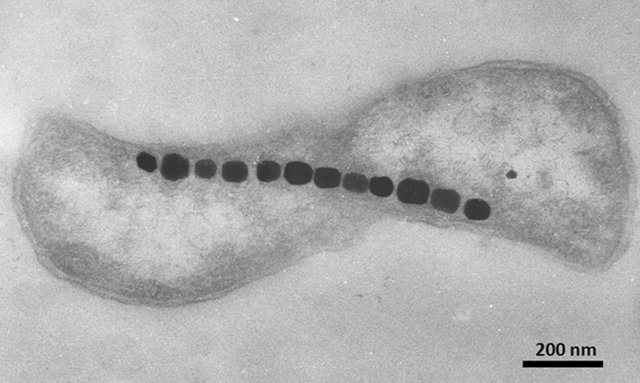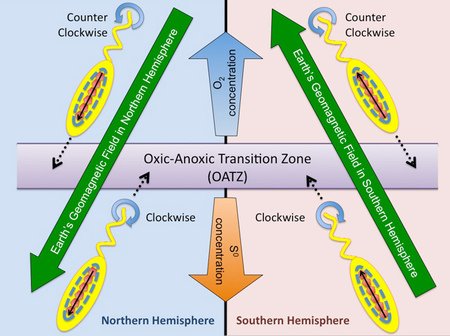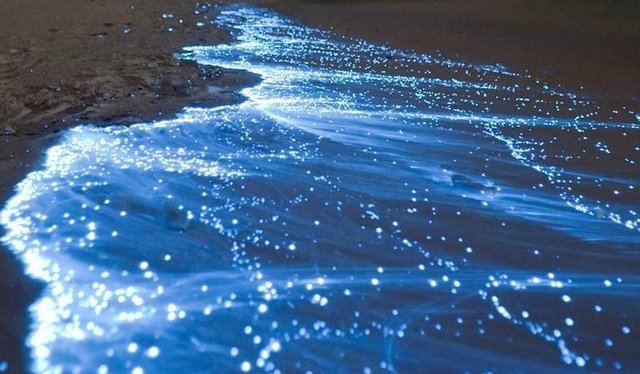Microbial World #8 Bacteria Synthesizes Nano-Sized Compasses to Navigate using Earth's Geometric Field
Bacteria uses Earth’s Geomagnetic Field to Navigate by synthesizing Nano-sized compasses
Hey Steemians,
Today in the series of Microbial world, I’ll be discussing on the movement of microbes (bacteria). You must have learned about the movement of bacteria, how they move? Can they control their movement or basically what pattern they follow to move and how they navigate themselves?

For those who don’t know about the shape of bacteria and what parts do they have? Bacteria can be of either rod shaped or cocci (round) shaped, basically they are divided into five different shapes but mostly they categorized in these two forms. So, if you look the bacterial cell, you will find these parts a cell, a flagella attached to it (if the bacteria is motile) and pilus (for attachment). These flagella are responsible for the movement, they rotate same like a motor clockwise (backward) and anticlockwise (forward), representing their movement.
You can easily see their movement in microscope, there are some species which instead of moving forward or reverse they tumble and covers the distance. So, the point today’s discussion is how do they do it?
Magnetic Iron nanominerals are synthesized by Magnetotactic Bacteria, they function as tiny compasses which provide navigation using Earth’s geomagnetic field.
Being most abundant element on earth, Iron is also an essential nutrient for all organism. It has a reduced state ferrous ion Fe(II) and an oxidized state ferric ion Fe(III), Iron present in ferric state in the aerobic environment and in anaerobic environment iron is present in the ferrous state. Iron cycle is bit complex earth’s biogeochemically and includes both biotic and abiotic types of oxidizing and reducing components.
A group of microorganism, called magnetotactic bacteria play’s a major role in the Earth’s iron cycle. Iron is very important for group of these magnetotactic bacteria not only because iron functions in many of their metabolic pathways but also because these group of bacteria store nanometer sized iron minerals incorporated in their body (1).

Magnetotactic bacteria were first documented in 1975 by Blakemore and was found that these bacteria are synthesizing a chain of nano sized magnetic particles, which is functioning as compass needle for the direction. These nano needles allowing the microbes to orient themselves in earth’s geomagnetic field. Bacteria synthesizes small magnetic particles by set of specified proteins and are present in membrane bound organelles called Magnetosomes (2). These nanoparticles in the bacteria provides the magnetic dipole to cell and allow them to sense Earth’s geomagnetic field. These magnetotactic bacteria also have flagella which provide them the mobility (3).
The process where bacteria moves according to the geomagnetic field and use their flagella to swim to anaerobic and redox environment is known as magnetotaxis. These bacteria are divided into three groups mainly on the basis of their synthesized magnetic minerals: magnetite, greigite or a combination of greigite and pyrite and a combination of magnetite and greigite (4). Few magnetite producing bacteria are cultivated in pure culture while still no bacteria producing gregite are cultured in pure form. These group of bacteria mostly present in the marine environment with less oxygen and high concentration of hydrogen sulfide. In addition to the contribution of iron cycle these hydrogen sulfide producing bacteria also plays a major role in the biogeochemical cycle of sulfur (5).
The process by which these magnetotactic bacteria synthesizes the Fe3O4 is still not clear. It is believed that several distinct steps are involved in this biomineralization process, which includes iron uptake by bacterial cell, formation of magnetosomes vesicle within bacteria, iron transport into these vesicles and protein mediated biomineralization within magnetosomes. Iron uptake in these bacteria vary from species to species, all this depends on the pH in which they survive making it oxidized or reduced (6).

Iron exist as Fe(III) in earth crust and insoluble at neutral pH, In order to utilize solid Fe(III) some bacterial sp. are known to synthesize iron-binding molecules called siderophore (7). These biomolecules are ferric ion chelators, after forming complex with the Fe(III) it enters the bacterial cell and then the Fe(III) get cleaved. Once inside, Fe(III) gets converted to Fe(II) which is taken up by the magnetosomes. MamB and MamM are observed to be responsible for the transport of iron into the magnetosomes (8).
Researchers have suggested that organism similar to Earth’s magnetotactic bacteria may be present in other planet too.
References
Gorby et. al., 1988 Characterization of the bacterial magnetosome membrane. 170(2); 834-841
Damien at. al., 2008 Magnetotactic Bacteria and Magnetosomes. 108(11);4875-4898
Neilands et.al., 1995 Siderophores: Structure and Function of Microbial Iron Transport Compounds.
Previous articles on Microbial World
Microbial World #5 Rise of Superbugs
Microbial World #6 Bioluminescent Bacteria
Microbial World #7 Halocin: Bacteriocin from halobacteria
Hope you have found this article inrteresting. If you do please upvote, resteem and comment.
Happy Reading :)
Vinamra
/bacteria_cell_drawing-5786db0a5f9b5831b54f017c.jpg)



Being A SteemStem Member
Magnetosomes, wow that was not covered in my biology college courses. Thank you for the well written blog post. I wonder about the biochemistry involved in the formation of those organelles. vinamra if you have any information about the biochemistry I would appreciate if you don't mind sharing it here or in a future blog post. Looking forward to more great work from you.
Thanks @rsc227, I'm happy to know that you find it interesting. I have not explained much on how the iron uptake work in the biochemistry view. But if you want to know I can send you the reference or you can find it in the reference section. Next time will try to include some biochemistry also in my articles, which might interests you.....
Thankyou for reading the article.
Cheers😊
Wow awesome mate ...
Thanks @lalu24